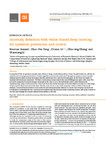Anomaly Detection with Vision-Based Deep Learning for Epidemic Prevention and Control
| dc.contributor.author | Samani, Hooman | |
| dc.contributor.author | Yang, C-Y | |
| dc.contributor.author | Li, Chunxu | |
| dc.contributor.author | Chung, C-L | |
| dc.contributor.author | Li, S | |
| dc.date.accessioned | 2022-01-26T10:44:35Z | |
| dc.date.issued | 2022-02 | |
| dc.identifier.issn | 2288-5048 | |
| dc.identifier.issn | 2288-5048 | |
| dc.identifier.uri | http://hdl.handle.net/10026.1/18619 | |
| dc.description.abstract |
During the COVID-19 pandemic, people were advised to keep a social distance from others. People’s behaviors will also be noticed, such as lying down because of illness, regarded as abnormal conditions. This paper proposes a visual anomaly analysis system based on deep learning to identify individuals with various anomaly types. In the study, two types of anomaly detections are concerned. The first is monitoring the anomaly in the case of falling in an open public area. The second is measuring the social distance of people in the area to warn the individuals under a short distance. By implementing a deep model named You Only Look Once, the related anomaly can be identified accurately in a wide range of open spaces. Experimental results show that the detection accuracy of the proposed method is 91%. In the social distance, the actual social distance is calculated by calculating the plane distance to ensure that everyone can meet the specification. Integrating the two functions and implementing the environmental monitoring system will make it easier to monitor and manage the disease-related abnormalities on the site. | |
| dc.format.extent | 187-200 | |
| dc.language | en | |
| dc.language.iso | en | |
| dc.publisher | Oxford University Press | |
| dc.subject | robotics for pandemics | |
| dc.subject | anomaly detection | |
| dc.subject | social distance | |
| dc.subject | deep learning | |
| dc.subject | computer vision | |
| dc.subject | epidemic prevention and control | |
| dc.title | Anomaly Detection with Vision-Based Deep Learning for Epidemic Prevention and Control | |
| dc.type | journal-article | |
| dc.type | Journal Article | |
| plymouth.author-url | https://www.webofscience.com/api/gateway?GWVersion=2&SrcApp=PARTNER_APP&SrcAuth=LinksAMR&KeyUT=WOS:000753589500004&DestLinkType=FullRecord&DestApp=ALL_WOS&UsrCustomerID=11bb513d99f797142bcfeffcc58ea008 | |
| plymouth.issue | 1 | |
| plymouth.volume | 9 | |
| plymouth.publication-status | Published | |
| plymouth.journal | Journal of Computational Design and Engineering | |
| dc.identifier.doi | 10.1093/jcde/qwab075 | |
| plymouth.organisational-group | /Plymouth | |
| plymouth.organisational-group | /Plymouth/Faculty of Science and Engineering | |
| plymouth.organisational-group | /Plymouth/Faculty of Science and Engineering/School of Engineering, Computing and Mathematics | |
| plymouth.organisational-group | /Plymouth/REF 2021 Researchers by UoA | |
| plymouth.organisational-group | /Plymouth/REF 2021 Researchers by UoA/UoA11 Computer Science and Informatics | |
| plymouth.organisational-group | /Plymouth/Users by role | |
| plymouth.organisational-group | /Plymouth/Users by role/Academics | |
| dcterms.dateAccepted | 2021-11-09 | |
| dc.rights.embargodate | 2022-2-16 | |
| dc.identifier.eissn | 2288-5048 | |
| dc.rights.embargoperiod | Not known | |
| rioxxterms.versionofrecord | 10.1093/jcde/qwab075 | |
| rioxxterms.licenseref.uri | http://www.rioxx.net/licenses/all-rights-reserved | |
| rioxxterms.licenseref.startdate | 2022-02 | |
| rioxxterms.type | Journal Article/Review |


